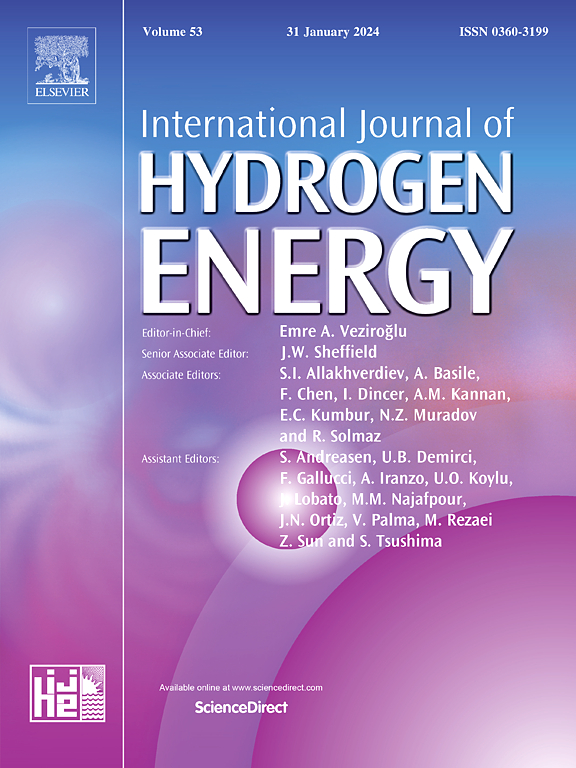Constructing g-C3N4/TiO2/Pt using natural titanium mines for efficient photocatalytic water splitting to produce hydrogen
IF 8.3
2区 工程技术
Q1 CHEMISTRY, PHYSICAL
引用次数: 0
Abstract
With the escalating energy crisis, clean and renewable hydrogen energy has emerged as a focal point of research. This study utilizes titanium concentrate as the primary raw material and employed a more convenient and efficient mechanical activation-oxidation-reduction-acid leaching process to effectively enrich TiO2, thereby producing a highly active and stable TiO2 photocatalyst substrate. To further enhanced its photocatalytic performance, this research developed a heterostructured mineral-derived material g-C3N4/TiO2-6/Pt. Experimental results indicated that the hydrogen evolution rate of the g-C3N4/TiO2-6/Pt composite material reached 6.42 mmol/g/h within 5 h, whereas that of g-C3N4/P25/Pt was only 5.92 mmol/g/h. This study underscores the significance of extracting TiO2 from titanium concentrate and its subsequent applications. By effectively utilizing titanium resources, it aims to address the increasing industrial demand for TiO2 while providing innovative solutions to combat environmental pollution and mitigate the energy crisis. These findings hold substantial theoretical and practical implications for advancing related fields.
利用天然钛矿构建g-C3N4/TiO2/Pt高效光催化水裂解制氢
随着能源危机的加剧,清洁可再生的氢能成为研究的热点。本研究以钛精矿为主要原料,采用更方便、高效的机械活化-氧化-还原-酸浸工艺,有效富集TiO2,从而制备出高活性、稳定的TiO2光催化剂底物。为了进一步提高其光催化性能,本研究开发了异质结构的矿物衍生材料g-C3N4/TiO2-6/Pt。实验结果表明,g- c3n4 /TiO2-6/Pt复合材料在5 h内的析氢速率达到6.42 mmol/g/h,而g- c3n4 /P25/Pt复合材料的析氢速率仅为5.92 mmol/g/h。本研究强调了从钛精矿中提取TiO2及其后续应用的重要性。通过有效利用钛资源,旨在解决日益增长的工业对TiO2的需求,同时为应对环境污染和缓解能源危机提供创新的解决方案。这些发现对推动相关领域的发展具有重要的理论和实践意义。
本文章由计算机程序翻译,如有差异,请以英文原文为准。
求助全文
约1分钟内获得全文
求助全文
来源期刊

International Journal of Hydrogen Energy
工程技术-环境科学
CiteScore
13.50
自引率
25.00%
发文量
3502
审稿时长
60 days
期刊介绍:
The objective of the International Journal of Hydrogen Energy is to facilitate the exchange of new ideas, technological advancements, and research findings in the field of Hydrogen Energy among scientists and engineers worldwide. This journal showcases original research, both analytical and experimental, covering various aspects of Hydrogen Energy. These include production, storage, transmission, utilization, enabling technologies, environmental impact, economic considerations, and global perspectives on hydrogen and its carriers such as NH3, CH4, alcohols, etc.
The utilization aspect encompasses various methods such as thermochemical (combustion), photochemical, electrochemical (fuel cells), and nuclear conversion of hydrogen, hydrogen isotopes, and hydrogen carriers into thermal, mechanical, and electrical energies. The applications of these energies can be found in transportation (including aerospace), industrial, commercial, and residential sectors.
 求助内容:
求助内容: 应助结果提醒方式:
应助结果提醒方式:


